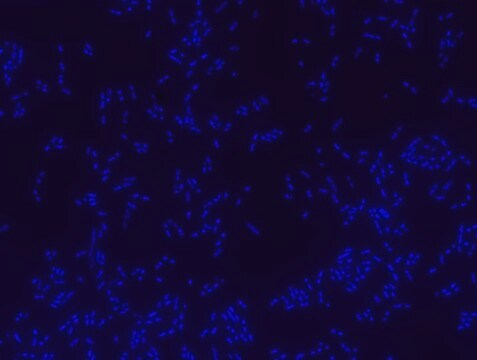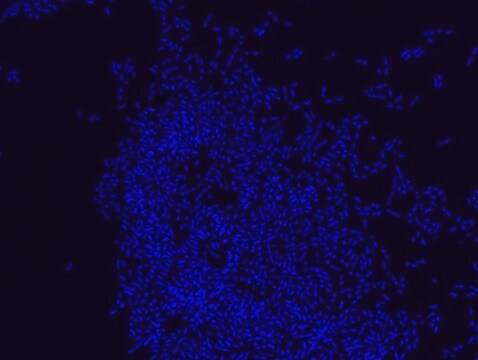MBD0035
Bacterial negative control FISH probe - Cy3
Probe for fluorescence in situ hybridization (FISH),20 μM in water
Iniciar sesiónpara Ver la Fijación de precios por contrato y de la organización
About This Item
UNSPSC Code:
12352200
NACRES:
NA.55
Productos recomendados
Quality Level
technique(s)
FISH: suitable
fluorescence
λex 550 nm; λem 570 nm (Cy3)
shipped in
dry ice
storage temp.
−20°C
General description
Fluorescent In Situ Hybridization technique (FISH) is based on the hybridization of fluorescent labeled oligonucleotide probe to a specific complementary DNA or RNA sequence in whole and intact cells.1 Microbial FISH allows the visualization, identification and isolation of bacteria due to recognition of ribosomal RNA also in unculturable samples.2
FISH technique can serve as a powerful tool in the microbiome research field by allowing the observation of native microbial populations in diverse microbiome environments, such as samples from human origin (blood3 and tissue4), microbial ecology (solid biofilms5 and aquatic systems6) and plants7.
Prokaryotic single cell life forms are divided into two domains, called Bacteria and Archaea, originally categorized as Eubacteria and Archaebacteria.8 However both terms, Eubacteria and Bacteria are still being used in microbiology.
The Negative control non-specific, nonsense probe, is used in the FISH experiments to detect nonspecific binding of the probes and set the appropriate conditions for the experiment.9
The negative control probe was used in FISH technique on various samples such as, pure culture (as described in the figure legends) and blood cultures9,10.
It is strongly recommended to include positive and negative controls in FISH assays to ensure specific binding of the probe of interest and appropriate protocol conditions. We offer positive (MBD0032/33) and negative (MBD0034/35) control probes, that accompany the specific probe of interest.
FISH technique can serve as a powerful tool in the microbiome research field by allowing the observation of native microbial populations in diverse microbiome environments, such as samples from human origin (blood3 and tissue4), microbial ecology (solid biofilms5 and aquatic systems6) and plants7.
Prokaryotic single cell life forms are divided into two domains, called Bacteria and Archaea, originally categorized as Eubacteria and Archaebacteria.8 However both terms, Eubacteria and Bacteria are still being used in microbiology.
The Negative control non-specific, nonsense probe, is used in the FISH experiments to detect nonspecific binding of the probes and set the appropriate conditions for the experiment.9
The negative control probe was used in FISH technique on various samples such as, pure culture (as described in the figure legends) and blood cultures9,10.
It is strongly recommended to include positive and negative controls in FISH assays to ensure specific binding of the probe of interest and appropriate protocol conditions. We offer positive (MBD0032/33) and negative (MBD0034/35) control probes, that accompany the specific probe of interest.
Application
Probe for fluorescence in situ hybridization (FISH), negative control probe used to detect nonspecific binding.
Features and Benefits
- Detection of nonspecific binding of tested probes.
- Verification of FISH results accuracy.
- Calibration of FISH experiment appropriate conditions.
- Can be used to control for nonspecific binding in variuos samples such as, blood cultures and pure cultures.
- The ability to detect bacteria in its natural habitat is an essential tool for studying host-microbiome interaction.
Storage Class
12 - Non Combustible Liquids
wgk_germany
nwg
flash_point_f
Not applicable
flash_point_c
Not applicable
Certificados de análisis (COA)
Busque Certificados de análisis (COA) introduciendo el número de lote del producto. Los números de lote se encuentran en la etiqueta del producto después de las palabras «Lot» o «Batch»
¿Ya tiene este producto?
Encuentre la documentación para los productos que ha comprado recientemente en la Biblioteca de documentos.
Dorothee Maria Gescher et al.
International journal of antimicrobial agents, 32 Suppl 1, S51-S59 (2008-08-23)
Sepsis is a life-threatening disease with a high mortality rate. Rapid identification of blood culture isolates plays a crucial role in adequate antimicrobial therapy in sepsis patients. To accelerate microbiological diagnosis, a comprehensive panel of oligonucleotide probes for fluorescence in
C R Woese et al.
Proceedings of the National Academy of Sciences of the United States of America, 87(12), 4576-4579 (1990-06-01)
Molecular structures and sequences are generally more revealing of evolutionary relationships than are classical phenotypes (particularly so among microorganisms). Consequently, the basis for the definition of taxa has progressively shifted from the organismal to the cellular to the molecular level.
V A Kempf et al.
Journal of clinical microbiology, 38(2), 830-838 (2000-02-03)
Using fluorescent in situ hybridization (FISH) with rRNA-targeted fluorescently labelled oligonucleotide probes, pathogens were rapidly detected and identified in positive blood culture bottles without cultivation and biotyping. In this study, 115 blood cultures with a positive growth index as determined
Sven Poppert et al.
Journal of medical microbiology, 59(Pt 1), 65-68 (2009-10-03)
This study evaluated fluorescence in situ hybridization (FISH) for rapid identification of Staphylococcus aureus and coagulase-negative staphylococci (CoNS) directly from blood cultures. Initially, 360 blood cultures containing Gram-positive cocci were investigated by a previously described microwave-FISH procedure: 44/49 (89.8 %)
Jiming Jiang
Chromosome research : an international journal on the molecular, supramolecular and evolutionary aspects of chromosome biology, 27(3), 153-165 (2019-03-11)
Fluorescence in situ hybridization (FISH) was developed more than 30 years ago and has been the most paradigm-changing technique in cytogenetic research. FISH has been used to answer questions related to structure, mutation, and evolution of not only individual chromosomes but
Nuestro equipo de científicos tiene experiencia en todas las áreas de investigación: Ciencias de la vida, Ciencia de los materiales, Síntesis química, Cromatografía, Analítica y muchas otras.
Póngase en contacto con el Servicio técnico








